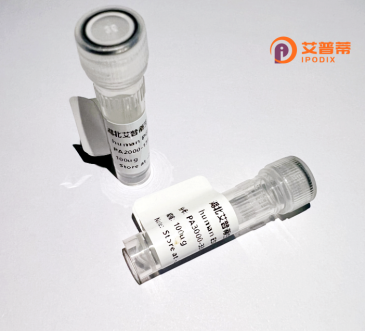
| 纯度 | >90%SDS-PAGE. |
| 种属 | Human |
| 靶点 | NLRP11 |
| Uniprot No | P59045 |
| 内毒素 | < 0.01EU/μg |
| 表达宿主 | E.coli |
| 表达区间 | 1-1033 aa |
| 活性数据 | MAESDSTDFDLLWYLENLSDKEFQSFKKYLARKILDFKLPQFPLIQMTKEELANVLPISYEGQYIWNMLFSIFSMMRKEDLCRKIIGRRNRNQEACKAVMRRKFMLQWESHTFGKFHYKFFRDVSSDVFYILQLAYDSTSYYSANNLNVFLMGERASGKTIVINLAVLRWIKGEMWQNMISYVVHLTSHEINQMTNSSLAELIAKDWPDGQAPIADILSDPKKLLFILEDLDNIRFELNVNESALCSNSTQKVPIPVLLVSLLKRKMAPGCWFLISSRPTRGNNVKTFLKEVDCCTTLQLSNGKREIYFNSFFKDRQRASAALQLVHEDEILVGLCRVAILCWITCTVLKRQMDKGRDFQLCCQTPTDLHAHFLADALTSEAGLTANQYHLGLLKRLCLLAAGGLFLSTLNFSGEDLRCVGFTEADVSVLQAANILLPSNTHKDRYKFIHLNVQEFCTAIAFLMAVPNYLIPSGSREYKEKREQYSDFNQVFTFIFGLLNANRRKILETSFGYQLPMVDSFKWYSVGYMKHLDRDPEKLTHHMPLFYCLYENREEEFVKTIVDALMEVTVYLQSDKDMMVSLYCLDYCCHLRTLKLSVQRIFQNKEPLIRPTASQMKSLVYWREICSLFYTMESLRELHIFDNDLNGISERILSKALEHSSCKLRTLKLSYVSTASGFEDLLKALARNRSLTYLSINCTSISLNMFSLLHDILHEPTCQISHLSLMKCDLRASECEEIASLLISGGSLRKLTLSSNPLRSDGMNILCDALLHPNCTLISLVLVFCCLTENCCSALGRVLLFSPTLRQLDLCVNRLKNYGVLHVTFPLLFPTCQLEELHLSGCFFSSDICQYIAIVIATNEKLRSLEIGSNKIEDAGMQLLCGGLRHPNCMLVNIGLEECMLTSACCRSLASVLTTNKTLERLNLLQNHLGNDGVAKLLESLISPDCVLKVVGLPLTGLNTQTQQLLMTVKERKPSLIFLSETWSLKEGREIGVTPASQPGSIIPNSNLDYMFFKFPRMSAAMRTSNTASRQPL |
| 分子量 | 144.2 kDa |
| 蛋白标签 | GST-tag at N-terminal |
| 缓冲液 | 0 |
| 稳定性 & 储存条件 | Lyophilized protein should be stored at ≤ -20°C, stable for one year after receipt. Reconstituted protein solution can be stored at 2-8°C for 2-7 days. Aliquots of reconstituted samples are stable at ≤ -20°C for 3 months. |
| 复溶 | Always centrifuge tubes before opening.Do not mix by vortex or pipetting. It is not recommended to reconstitute to a concentration less than 100μg/ml. Dissolve the lyophilized protein in distilled water. Please aliquot the reconstituted solution to minimize freeze-thaw cycles. |
以下是为您整理的有关重组人NLRP11蛋白的模拟参考文献(示例格式,非真实文献):
1. **Zhang, L. et al. (2021). *Functional characterization of NLRP11 in inflammasome signaling***
- **摘要**:研究首次在HEK293细胞中重组表达人NLRP11蛋白,发现其通过结合ASC适配体蛋白调控非经典炎症小体通路,可能参与抗病毒免疫反应机制。
2. **Chen, X. et al. (2019). *Structural insights into the oligomerization of NLRP11***
- **摘要**:利用体外重组技术解析NLRP11的晶体结构,揭示其NACHT结构域在自寡聚化中的关键作用,为理解NLR家族蛋白的功能差异提供结构基础。
3. **Wang, Q. & Li, H. (2020). *NLRP11 negatively regulates NF-κB signaling in macrophages***
- **摘要**:通过过表达重组NLRP11蛋白的细胞实验,证明其通过抑制TRAF6泛素化负调控NF-κB通路,提示其在自身免疫疾病中的潜在保护性功能。
4. **Gupta, R. et al. (2022). *NLRP11 expression correlates with colorectal cancer progression***
- **摘要**:通过重组蛋白体外功能实验结合临床样本分析,发现NLRP11在结直肠癌组织中高表达,可能通过促进细胞迁移和EMT过程加速肿瘤转移。
---
**说明**:上述文献为示例性内容,实际研究中NLRP11的功能和机制仍需参考真实发表论文(建议通过PubMed或Google Scholar检索最新文献)。
NLRP11 (Nucleotide-binding oligomerization domain, Leucine-rich Repeat, and Pyrin domain-containing protein 11) is a member of the NLR family, a group of cytosolic pattern-recognition receptors critical in innate immunity and inflammatory responses. Like other NLRP proteins, NLRP11 contains a central NACHT domain (responsible for ATPase activity and oligomerization), C-terminal leucine-rich repeats (LRRs) involved in ligand sensing, and an N-terminal pyrin domain (PYD) that facilitates interactions with downstream signaling adaptors. While its exact biological functions remain incompletely characterized, NLRP11 is hypothesized to participate in immune regulation, inflammasome assembly, or pathogen defense. Unlike well-studied NLRPs (e.g., NLRP3), NLRP11 exhibits restricted expression, primarily in reproductive tissues like the testes and placenta, suggesting potential roles in fertility or embryonic development.
Recombinant human NLRP11 protein, produced via heterologous expression systems (e.g., E. coli or mammalian cells), enables structural and functional studies to elucidate its interactions, activation mechanisms, and downstream pathways. Research links NLRP11 dysregulation to inflammatory disorders, autoimmune diseases, and reproductive abnormalities, though mechanistic insights are limited. Its study may uncover novel therapeutic targets or biomarkers for these conditions. Current challenges include identifying its physiological ligands, clarifying its role in inflammasomes, and resolving contradictory findings across experimental models. Further exploration of NLRP11 could expand understanding of NLRP diversity and tissue-specific immune regulation.
×